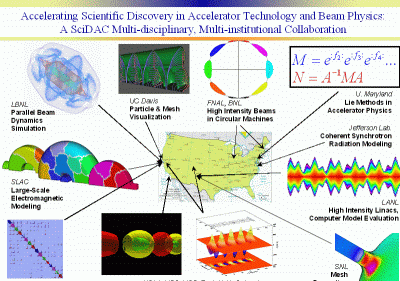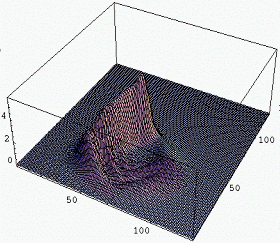
High performance computing (SciDAC: Scientific Discovery through Advance Computing, NERSC, CSCAMM): click here.
Research on the quantum dynamics of relativistic particles and the electromagnetic field with applications to accelerator and beam physics: click here.
Research on quantum computing in collaboration with the Superconducting Quantum Computing Group: click here.
High performance computing is an important research tool of the Dynamical Systems and Accelerator Theory Group at the University of Maryland. We participate in the "Advanced Computing for 21st Century Accelerator Science and Technology" collaboration, a part of the SciDAC (Scientific Discovery through Advanced Computing) initiative at NERSC (the National Energy Research Scientific Computing Center). Click here to see a graphic of this multi-institutional and multidisciplinary program. As part of this effort we make use of NERSC's flagship supercomputer SEABORG, a massively parallel (2,944 processors) 1.5 Teraflop/sec IBM RS/6000 SP.
Examples of research requiring high performance computing include: PIC (particle-in-a-cell) code simulation of space charge and multiparticle beam dynamics, a high-performance version of MaryLie, and quantum codes simulating radiation reaction and quantum fluctuation driven emittance growth in beam dynamics.
The Dynamical Systems group has close ties with Los Alamos National Laboratory where, for example, MaryLie is used as an important tool in the design of a number of accelerator based technologies (e.g. proton radiography). We participate in the new Center for Scientific Computing and Mathematical Modeling (CSCAMM) at the University of Maryland, whose resources include a 16 node IBM SP/2 named DAWSON.

The fundamental theory underlying charged particle and electromagnetic field dynamics is QED (quantum electrodynamics). In practice quantum effects are usually negligible for a variety of (related) reasons: large numbers of particles, large energies (compared to the ground state and energy level separations), decoherence, dephasing, noise, etc. But there are important processes in beam physics where the quantum origin of basic phenomena are significant. Radiation reaction for points particles does not have a consistent classical description (e.g. the famous Abraham-Lorentz-Dirac equation predicts runaway or acausal solutions). Quantum fluctuations from photon emission during synchrotron radiation generates emittance growth in beams. These two examples limit the emittance and energies of synchrotron radiation dominated accelerators.
In general, the quantum dynamics of particles in nonlinear fields (e.g. quadruple magnets) is not well understood. A first principles based study of nonlinear quantum systems of many types is possible with nonperturbative quantum algorithms running on high performance computing platforms. For more description of this research click here.
Members of the Dynamical Systems and Accelerator Theory Group are collaborating with the Superconducting Quantum Computing Group in the project to build a quantum computer using superconducting quantum interference devices (SQUIDS) and Josephson junctions. For more information about this effort see the SQC home page